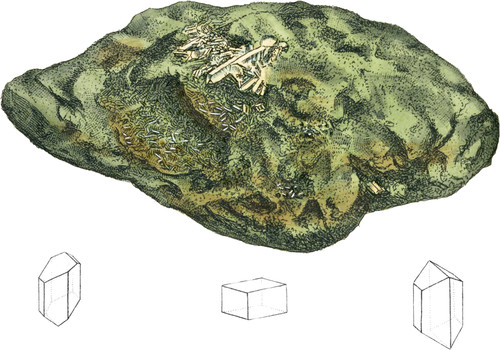 Enlarge
Enlarge
British Mineralogy
Epidote
- Class 2. Earths.
- Ord. 1. Homogeneous.
- Gen. 4. Silex.
- Spec. . Episote
- Div. 1. Crystallized.
- Syn.
- Epidote. Haüy, Traité, 3. 102. Tabl. 34, 184.
- Glasiger Strahlstein. Emmerl. 1. 422.
- Glassy Actinolite. Kirw. 1. 168.
When I first turned my attention to Mineralogy a few years since, I found a mass of this substance in a pavier’s yard in Westminster, who imported stones from Scotland and Guernsey. I expected the stones, being unwrought or bowlders, were from the latter place, and my suspicions were confirmed by my friend Dr. MacCulloch who brought me a specimen from thence. I next received some from, the neighbourhood of Keswick, where it occurs in veins in Trap, accompanied by Quartz, Carbonate of Lime, and Compact Feldspar, for the first lime proving it to be a British production. The present specimen from the same place, and in the possession of the discerning Mr. Lowry, which has minute and perfect crystals on it, confirms it as such. It is said to have been first observed in Dauphiny, and afterwards in Germany, France, Bavaria, and Norway. Thus it Is rather newly known as British, and I presume will not be found unfrequent. It appears by Mr. Horner’s paper in the Transactions of the Geological Society, that it is a constituent part of the rock composing the end hill of the range of Malvern hills, where it is granular, and mixed with grains of Hornblende. The crystals are of a light or dark yellowish green, powder lighter. The primitive, according to Haüy, is an upright prism, whose bases are parallelograms with oblique angles of 104° 37′.
The figures at the bottom show the varieties that are to be found on the present specimen. The regular crystals are minute and scattered over the surface of a rugged mass of the same substance, composed of nearly parallel fibres, or acicular crystals grouped side by side; in other places the fibres are larger and penetrate crystals of Quartz. It does not become electric by heat ; it melts into a black slag by the help of the blowpipe. Spec. Grav. 3.4529 to 3.46.
| Analysis by Descotils. | By Vauquelin. | |
|---|---|---|
| Silica | 37 | 37 |
| Alumina | 27 | 21 |
| Lime | 14 | 15 |
| Oxide of Iron | 17 | 24 |
| Oxide of Manganese | 1.5 | 1.5 |
| Loss | 3.5 | 1.5 |
| 100.0 | 100.0 |

